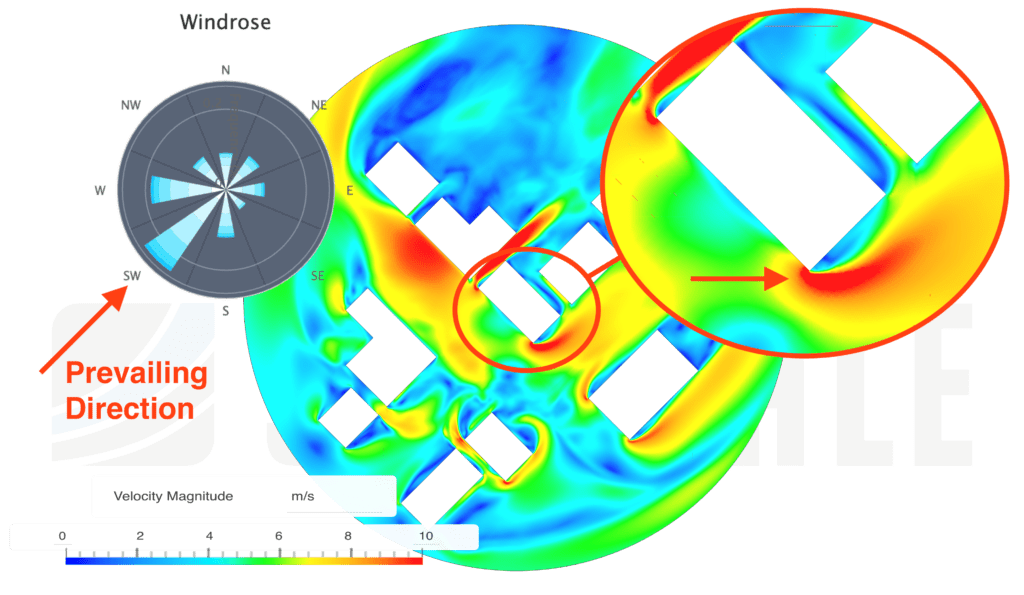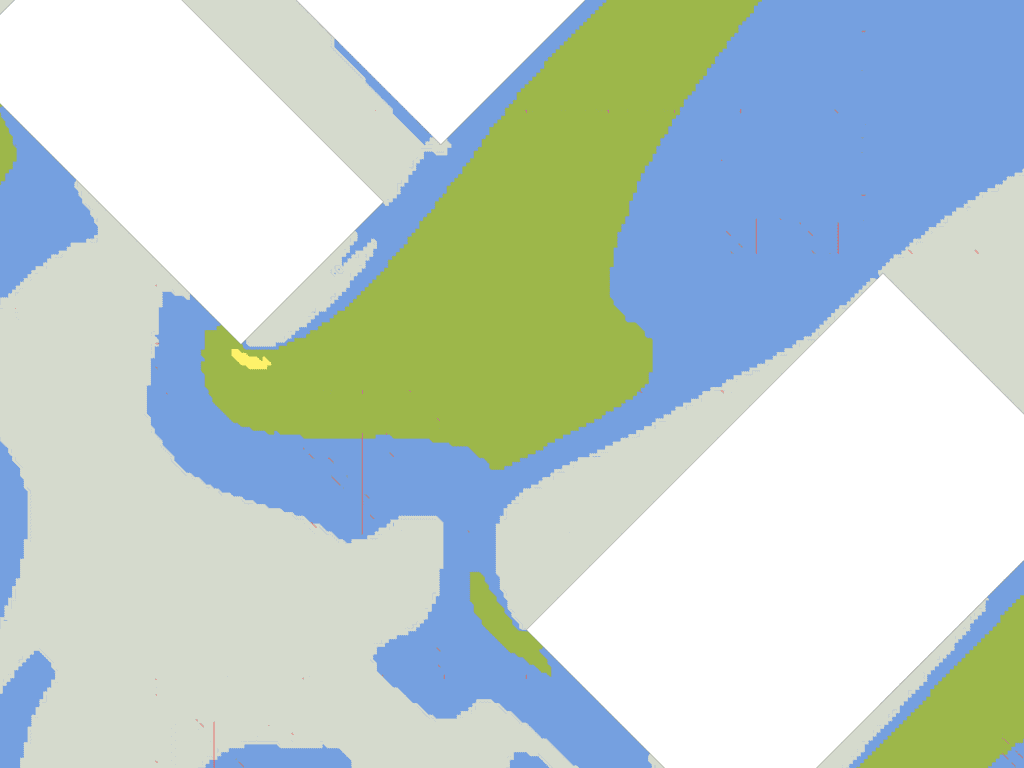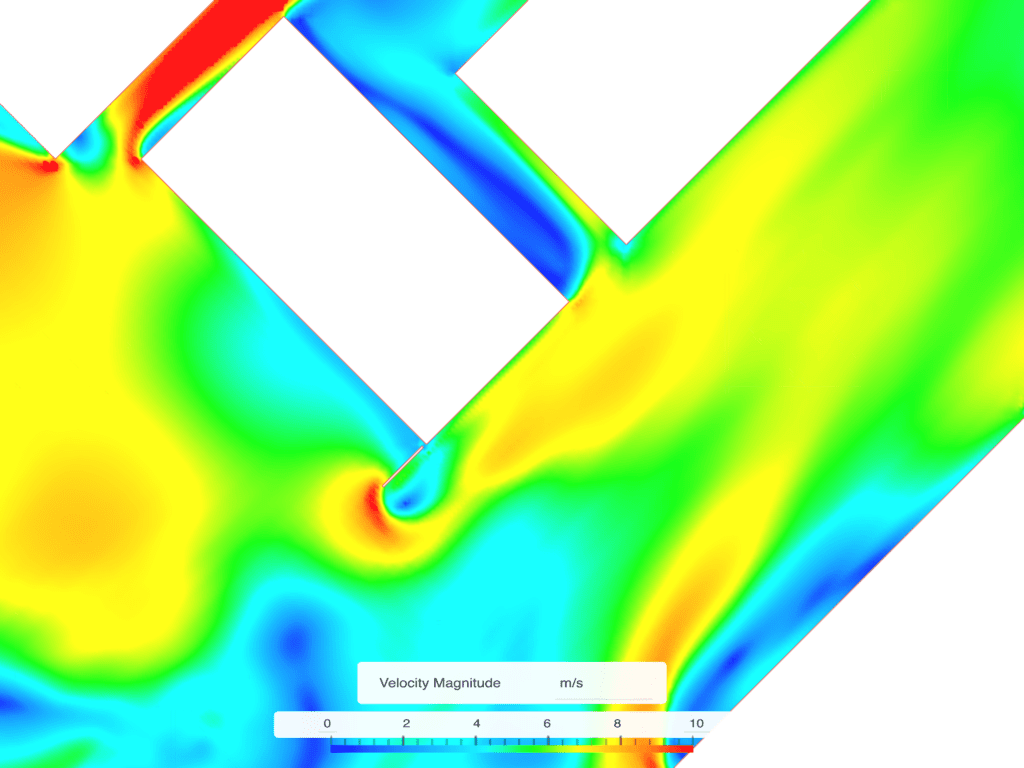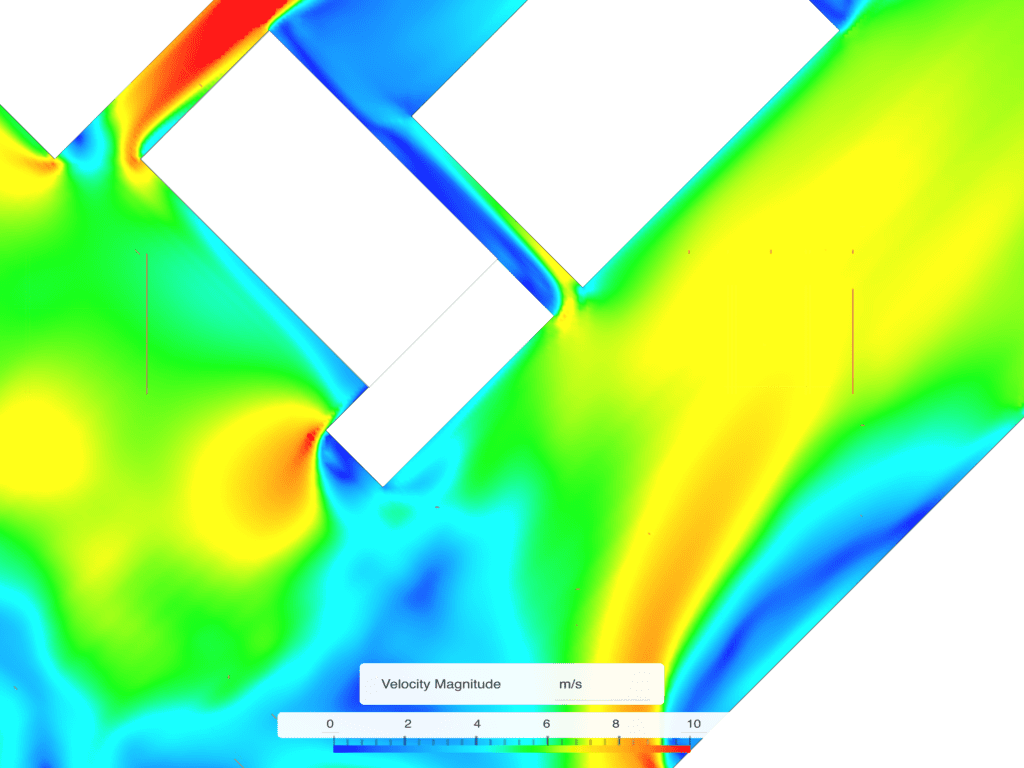Picture yourself strolling through a vibrant urban landscape, only to encounter a street corner where the wind suddenly picks up, tugging at your clothes and challenging your comfort. This phenomenon, known as the cornering effect, plays a significant role in shaping the pedestrian experience in windy cities. As the wind encounters sharp corners and intersections, it undergoes a transformative journey, accelerating and intensifying its force. In this article, we delve into the intricate relationship between urban design, wind dynamics, and pedestrian comfort, uncovering five strategies to mitigate the cornering effect and ensure optimal wind comfort for pedestrians. Join us on this exploration as we navigate the complexities of wind flow and discover actionable solutions to overcome the cornering effect to create more pleasant and inviting urban environments.
All the CFD simulations used in this post are publicly available here.
Understanding the Cornering Effect
To effectively mitigate the cornering effect and enhance pedestrian wind comfort, it is essential to comprehend the underlying dynamics of wind behavior at street corners and intersections. Wind flow at corners is influenced by various factors, including building geometry, street alignment, and surrounding urban morphology. By understanding these factors, we can gain valuable insights into how wind interacts with the built environment, leading to improved design strategies.
Wind Flow Patterns and Pressure Distribution
At street corners, the wind encounters changes in direction and flow patterns, resulting in accelerated airflow and pressure variations. A key aspect to grasp is the creation of a wind vortex, where the wind wraps around the corner, generating intense gusts. Visualizing these wind flow patterns is crucial to understanding the specific areas where the cornering effect manifests.
The illustration above shows how a building’s sharp edge causes the flow to separate around the corner, and if the building is long enough, re-attach to its wall. A rotation in the flow is formed between those two points, often called the corner vortex. The stream of wind separating around the corner is strong, whereas the vortex core tends to be slower.
Recognising the Cornering Effect
One of the most effective ways to identify and analyze the cornering effect is through the use of Computational Fluid Dynamics (CFD). This powerful tool allows engineers and designers to simulate and visualize wind flow patterns, pressure distributions, and velocity fields around buildings and street corners. By harnessing the capabilities of CFD, designers and engineers can gain valuable insights into the complex dynamics of the cornering effect, facilitating the development of targeted mitigation strategies. Join us as we explore how CFD empowers us to unravel the intricacies of wind behavior, paving the way for enhanced urban design and improved pedestrian wind comfort.
Comfort plot
Comfort plots generated by CFD tools provide a visual representation of the impact of the cornering effect on pedestrian comfort. When analyzing comfort plots to identify the cornering effect, focus on areas where pedestrian activities such as walking or uncomfortable exist, indicating intensified wind and gusts. These areas are typically found in proximity to the corners of buildings and often exhibit a curved shape aligning with the wind flow direction.
The corner effect is not always this identifiable in the comfort plot in the presence of more complex urban environments. Therefore, when there is an area of discomfort that is in close proximity to the corner as above but more complex in shape, a user should proceed to inspect directional wind results.
Directional Wind Speeds
The prevailing wind direction is crucial in identifying influential corners where the cornering effect significantly impacts pedestrian wind discomfort. When examining comfort plots and wind speeds for the prevailing wind direction, focus on regions that exhibit cornering effect characteristics. These wind direction results are particularly useful for mitigating the cornering effect. By identifying areas with heightened wind speeds and increased pedestrian discomfort aligned with the prevailing wind direction, designers gain valuable insights for implementing targeted measures to improve pedestrian wind comfort in specific wind conditions.

As we can see in the above example, the cornering effect visible in the comfort plot is pronounced when looking at the directional result for the prevailing wind direction, reinforcing what was mentioned above.
5 Strategies for Mitigating the Cornering Effect
Addressing the cornering effect is crucial to improving pedestrian wind comfort in urban environments. By implementing effective strategies, we can optimize the design and layout of streets and buildings to minimize the impact of wind and gusts at corners and intersections. In this section, we explore a range of practical and innovative approaches to mitigate the cornering effect. From urban planning and greenery integration to smart street furniture and building design considerations, these strategies offer insights and solutions to create harmonious and wind-resistant urban spaces. Let’s dive in and discover how we can shape our cities to provide optimal wind comfort for pedestrians.
1. Urban Planning and Street Layout
Urban Planning and Street Layout are essential tools for mitigating the cornering effect and improving pedestrian wind comfort. By strategically designing street orientations, optimizing building placement and configuration, and considering street width and design, urban planners can create environments that minimize wind and turbulence and can enhance the comfort and safety of pedestrians around corners. Through thoughtful urban planning and street layout, cities can foster pedestrian-friendly spaces that effectively address the challenges posed by the cornering effect.
Here are three key areas that can be improved:
- Street Orientation: Aligning streets with the prevailing wind direction can minimize the impact of the cornering effect. By orienting streets parallel to the prevailing wind, the flow of air can be more streamlined, reducing the intensity of wind gusts at street corners.
- Building Placement and Configuration: The arrangement and design of buildings can help mitigate the cornering effect. Placing buildings strategically to create open spaces or courtyards can allow for better wind dispersion and minimize the concentration of wind around corners. Incorporating rounded or chamfered building corners can also help redirect wind and reduce turbulence.
- Street Width and Design: Proper street width and design can influence wind behavior. Wide streets and generous setbacks between buildings can create more open spaces, allowing for better air movement and dispersion of wind. Additionally, strategically using street furniture, landscaping, and other design elements can help create windbreaks and control airflow.
Consider the following example to illustrate the influence of street alignment on mitigating the cornering effect.


In one scenario, the streets are aligned with the prevailing wind direction, but a perpendicular street intersects them, resulting in poor pedestrian comfort, as shown in the wind comfort plot. However, in another scenario with two parallel streets aligned with the prevailing wind, the wind comfort plot demonstrates a significant improvement in pedestrian comfort. The corresponding wind speed plot further supports the benefits of parallel street alignment by showing reduced turbulence and more even wind distribution. These images highlight the importance of avoiding perpendicular street intersections and aligning streets with the prevailing wind to minimize the cornering effect and enhance pedestrian wind comfort in urban environments.




2. Urban Vegetation and Greenery
Urban vegetation and greenery offer multiple benefits in mitigating the cornering effect while providing additional advantages.
Benefits of trees and vegetation for wind mitigation:
- Windbreaks: Well-placed vegetation acts as natural windbreaks, reducing the speed and intensity of wind gusts. Planting trees, shrubs, or hedges strategically near street corners and building edges can create a buffer zone that disrupts and deflects the wind, minimizing its impact on pedestrians.
- Airflow Guidance: Vegetation can help guide and direct airflow in desired directions. By strategically positioning trees and plants, planners can influence the flow of wind, diverting it away from pedestrian areas or promoting more favorable wind patterns that reduce turbulence and discomfort at corners.
- Turbulence Reduction: Vegetation has the ability to break up and dissipate turbulent airflow. When wind encounters vegetation, it creates a complex flow pattern, leading to the dissipation of energy and a reduction in wind turbulence. This can result in smoother airflow around corners, minimizing the adverse effects of the cornering effect on pedestrians.
Some additional benefits we get from trees and vegetation:
- Microclimate Modification: Urban vegetation contributes to the creation of microclimates by providing shade and cooling effects. By reducing the overall temperature in urban spaces, vegetation helps to alleviate thermal discomfort caused by wind chill factors and enhances pedestrian comfort near corners.
- Visual and Psychological Benefits: Apart from its functional benefits, urban vegetation also provides aesthetic and psychological advantages. Green spaces and lush surroundings have a calming effect on individuals, making pedestrian areas more appealing and inviting. This can encourage people to spend more time outdoors and enjoy public spaces, even in wind-prone areas.
Consider the following example that demonstrates the positive impact of placing a tree on a building corner in reducing the cornering effect. By strategically positioning a tree at the corner of a building, the wind dynamics can be significantly altered. The tree acts as a natural windbreak, disrupting the airflow and reducing wind speeds in the immediate vicinity.


This can be observed in the wind comfort plot generated through computational fluid dynamics (CFD), where the presence of the tree shows a notable improvement in pedestrian comfort compared to the scenario without the tree. Additionally, analyzing the wind speed plot derived from CFD reveals how the tree effectively deflects and slows down the wind, creating a more favorable and comfortable environment for pedestrians around the corner of the building. The visual representations provided by these images serve as compelling evidence of how strategic placement of vegetation can mitigate the cornering effect and enhance pedestrian wind comfort in urban settings.




3. Street Furniture and Design
By integrating street furniture and design elements in a thoughtful manner, designers can enhance wind mitigation efforts while simultaneously elevating the visual appeal, functionality, and livability of urban spaces.
Here are a few Street Furniture and Design techniques you can employ to mitigate the cornering effect:
- Wind-Permeable Structures: Incorporate wind-permeable structures such as open grid benches, perforated screens, or lattice structures. These elements allow air to pass through and minimize the creation of turbulent zones. By reducing wind pressure buildup, they help alleviate the cornering effect and improve pedestrian comfort.
- Sheltered Seating Areas: Design seating areas that provide shelter and protection from wind. By strategically placing benches, seating pods, or alcoves in areas shielded from the prevailing wind, pedestrians can find respite from gusts and enjoy comfortable outdoor seating.
- Windbreaks and Canopies: Utilize windbreaks and canopies strategically placed along walkways or near building corners. These structures act as physical barriers to deflect and redirect wind, creating more sheltered and calm areas for pedestrians.
Imagine a bustling urban street where an innovative solution was employed to mitigate the cornering effect and enhance pedestrian wind comfort. At the corner of a building’s windward facade, an advertising billboard was strategically introduced as functional street furniture. Not only does it serve its primary purpose of displaying advertisements, but this intelligently designed billboard also acts as a wind deflector, redirecting the flow of wind upward and away from pedestrians.


Four impactful images provide a visual analysis of the scenario, comparing a baseline scenario with no street furniture to an improved scenario with the introduced advertising billboard. The first image depicts a pedestrian wind comfort plot, revealing discomfort zones near the corner in the baseline scenario. The second image shows the improved scenario with the billboard, demonstrating enhanced pedestrian comfort and improved airflow. The third image illustrates the wind speed distribution in the baseline scenario, highlighting areas of high velocity and turbulence. In contrast, the fourth image displays the transformed wind speed distribution in the improved scenario, with smoother airflow due to the billboard’s presence. These images emphasize the positive impact of street furniture in mitigating the cornering effect, enhancing pedestrian comfort, and reducing turbulence.




4. Building Setbacks and Façade Design
Building setbacks and façade design are crucial considerations in mitigating the cornering effect and enhancing pedestrian wind comfort. By incorporating appropriate setbacks and thoughtful façade design, architects and designers can minimize the impact of wind turbulence and create more comfortable environments for pedestrians. Setbacks provide valuable space between buildings and the street, allowing for improved airflow and reduced wind concentration at corners. Additionally, façade design plays a key role in shaping wind patterns and redirecting airflow, reducing wind pressures and creating sheltered zones. Together, building setbacks and façade design strategies contribute to enhancing pedestrian comfort and fostering pleasant and livable urban spaces.
As a designer, there are several strategies you can employ regarding building setbacks and façade design to mitigate the cornering effect and enhance pedestrian wind comfort:
- Setback Optimization: Consider incorporating appropriate setbacks between buildings and the street to allow for smoother airflow and reduce wind concentration at corners. Strategic placement of buildings can help create sheltered areas and minimize the impact of wind turbulence on pedestrians.
- Façade Openings: Carefully design façade openings such as windows, balconies, or recesses to control airflow. By directing the flow of air around the building and reducing wind pressures, you can create more comfortable spaces for pedestrians. Properly positioned openings can promote natural ventilation while minimizing the effects of the cornering effect.
- Wind-Resistant Materials: Select wind-resistant materials for the façade that can withstand the impact of wind forces. Incorporate design elements that reduce wind loads, such as streamlined shapes, rounded corners, and smooth surfaces. This helps to minimize the creation of vortices and turbulent areas, improving pedestrian comfort.
- Deflection and Diversion: Employ design features such as canopies, awnings, or windbreakers at key locations to deflect or divert wind away from pedestrian areas. These elements can create sheltered zones, reducing wind speeds and providing more comfortable conditions for pedestrians.
Let’s explore an example where a setback was ingeniously employed to divert the flow of wind up and over a building corner, effectively mitigating the cornering effect and enhancing pedestrian wind comfort. In this scenario, the designer strategically incorporated a setback between the building and the adjacent street. By introducing this setback, a space was created that allowed for the redirection of airflow.
As the wind approaches the building, it encounters the setback, which acts as an obstacle and alters the wind’s path. Instead of directly hitting the building corner and creating turbulence, the setback diverts the airflow upwards. This redirection causes the wind to flow over the corner, reducing the wind and turbulence experienced at ground level.


CFD simulations comparing a baseline scenario without a setback and an improved scenario with a setback demonstrate the effectiveness of the design strategy. The pedestrian wind comfort plot for the baseline scenario shows discomfort and increased turbulence near the building corner, while the improved scenario with the setback significantly improves pedestrian comfort. The wind speed plot confirms the reduction in turbulence and cornering effect in the improved scenario compared to the baseline. These results highlight the positive impact of the setback in enhancing pedestrian wind comfort and emphasize the importance of CFD simulations in guiding design decisions.




5. Computer Simulations and Wind Studies
Computer simulations and wind studies are invaluable tools in understanding and mitigating the cornering effect in pedestrian wind comfort. Through advanced computational fluid dynamics (CFD) simulations, engineers and designers can accurately model and analyze airflow patterns around buildings, streets, and urban layouts. These simulations provide insights into wind speed, direction, and turbulence, allowing for the identification of areas prone to the cornering effect. By simulating various design scenarios and evaluating their impact on pedestrian comfort, practitioners can make informed decisions about building placement, street orientation, and the integration of mitigation strategies. Computer simulations and wind studies empower professionals to optimize urban designs, create more comfortable outdoor spaces, and prioritize pedestrian well-being in wind-prone environments.
Conclusion
In conclusion, mitigating the cornering effect in pedestrian wind comfort requires a multifaceted approach that encompasses various strategies and design considerations. By incorporating strategies such as building setbacks, façade design optimization, urban vegetation, and thoughtful street layout, designers and urban planners can create more comfortable and enjoyable environments for pedestrians.
Through the use of computer simulations and wind studies, professionals can gain valuable insights into wind patterns, identify areas prone to the cornering effect, and evaluate the effectiveness of design interventions. These tools enable them to make informed decisions, optimize urban designs, and prioritize pedestrian well-being.
The presented examples highlight the effectiveness of these strategies in mitigating the cornering effect. Whether it’s the redirection of airflow through setback design or the use of vegetation as windbreaks, each strategy contributes to reducing wind pressures, minimizing turbulence, and enhancing pedestrian comfort.
By considering these strategies collectively and tailoring them to specific urban contexts, designers can create harmonious outdoor spaces that not only provide protection from wind discomfort but also foster a sense of place, connectivity, and livability.
In summary, by integrating these strategies into the design process, we can create urban environments that prioritize pedestrian comfort, enhance the quality of outdoor experiences, and promote sustainable and enjoyable cities for all.




